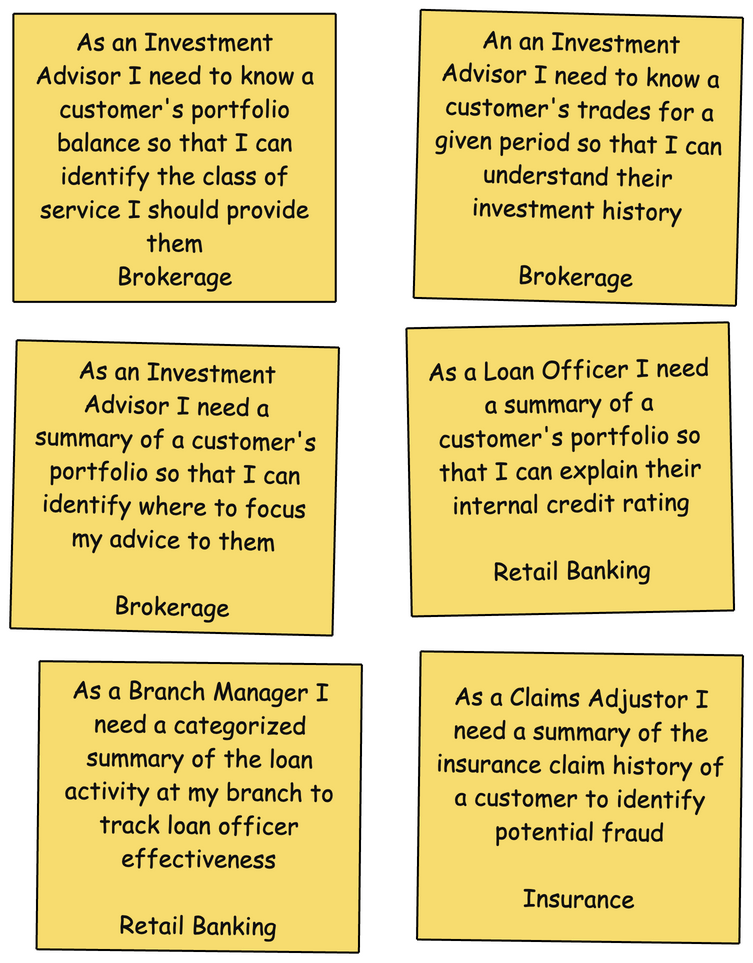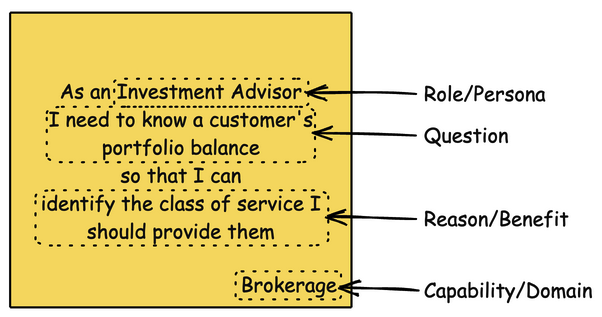Question Stories: Extending User Stories for Data
A question story is a specialized user story specific to data-oriented requirements. Question stories should be small and ideally implementable within a few hours or days by the person(s) taking on the work. Question stories describe thin slices of consumable value.
The following are examples of question stories:

Why Question Stories?
Question stories are used to capture requirements for data products, in particular, data analytics and data warehouse (DW)/business intelligence (BI) solutions. Because data initiatives exist to help people leverage data to make better-informed decisions, to answer questions, it makes sense to identify what questions people hope to answer. This enables you to focus on the outcome, answering questions, rather than the implementation, the structure of the data.
How to Capture Question Stories
Question stories are written in the following format:
There are four potential sections to a question story:
- Role/persona. How does the user fit into the overall business process?
- Question. What do they need to know to do their job better?
- Reason/benefit (optional). Why does the user need to know this? Indicating the reason is highly recommended because it provides context for prioritizing the work.
- Capability/domain. Many organizations choose to trace requirement items, such as stories, back to higher-level enterprise capabilities or domains.
Are Question Stories Complete Requirements?
No.
To paraphrase Ron Jeffries, a question story is a reminder to have a conversation with your stakeholders. I consider a question story as a start at an understanding of what your stakeholder needs you to provide. You need to collaborate closely with them to explore what they really need to answer, why they need to answer this question, when they need the answer, and how they would like the answer provided to them.
How to Identify Question Stories
Question stories, like other agile models, are best identified with your stakeholders. Better yet, because question stories are so straightforward, your stakeholders themselves can often write them. Never underestimate the power of active stakeholder participation.
To identify question stories, I will often ask people:
- What keeps you up at night?
- What do you wish you understood better?
- What would you like to know about the outcomes being achieved by your team?
- Do you know why your customers do what they do?
- Do you know why your colleagues do what they do?
- What decisions do you regularly make?
- What will you need to decide upon soon?
Definitions of Ready (DoRs) for Question Stories
Many agile/Scrum teams have a DoR that defines the minimum level of quality of the work that needs to be put into a story before the team is willing to work on it. This is true of question stories as well as of more general user stories. The DoR for a question story may include, but is not limited to:
- Data element definitions
- Calculation rules/algorithms
- Data source mappings
- Data source access information
- Desired format/platform/media for the answer
- Stakeholder contact information
Question Stories in Context
The following table summarizes the trade-offs associated with question stories and provides advice for when to adopt them.
Table 1. Question stories in context.
| Advantages |
|
| Disadvantages |
|
| When to Adopt Question Stories | When you are identifying stakeholder needs for information. |
Related Resources
Recommended Reading

This book, Choose Your WoW! A Disciplined Agile Approach to Optimizing Your Way of Working (WoW) – Second Edition, is an indispensable guide for agile coaches and practitioners. It overviews key aspects of the Disciplined Agile® (DA™) toolkit. Hundreds of organizations around the world have already benefited from DA, which is the only comprehensive toolkit available for guidance on building high-performance agile teams and optimizing your WoW. As a hybrid of the leading agile, lean, and traditional approaches, DA provides hundreds of strategies to help you make better decisions within your agile teams, balancing self-organization with the realities and constraints of your unique enterprise context.
I also maintain an agile database books page, which overviews many books you will find interesting.

